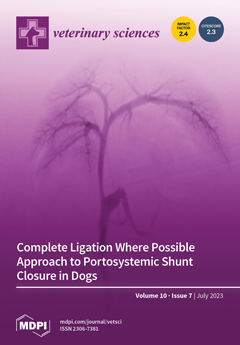Grape pomace (GP) is an industrial by-product of grape juice making and is commonly discarded as a waste product, even with its large quantity of phytochemicals. Thus, the objectives of this trial were to examine the effects of graded dietary GP on laying rate, egg quality, yolk lipid profile, oxidative stability, shell quality and ultrastructure, and serum biochemistry. Two hundred 35-week-old laying hens were allocated to four dietary treatments with ten replicates each. Four diets were formulated by mixing a standard basal diet with GP at 0 g/kg (control), 30 g/kg (GP
3%), 60 g/kg (GP
6%), and 90 g/kg (GP
9%). Egg production percent, egg weight, and egg mass were linearly improved (
p < 0.01) due to adding GP to the diets of laying hens. Eggs obtained from laying hens fed with GP diets had (
p < 0.01; linear,
p < 0.01) greater Haugh units, yolk color, albumen index, and yolk index than those of the control. The GP
9% group had the greatest values (
p < 0.05) for shell weight, thickness, and breaking strength. Electron microscopy scanning of eggshells indicated that the incremental dietary level of GP linearly augmented the thickness of the palisade layer but reduced both the mammillary layer and mammillary knob width (
p < 0.01). Improved tibia-breaking strength and ash content were shown (
p < 0.05) in the GP-fed laying hens. The dietary addition of GP by up to 90 g/kg linearly (
p < 0.01) mitigated lipid oxidation and improved the antioxidant capacity in both the serum and stored eggs. A reduction in the percentages of saturated fatty acids was observed, while the contents of monounsaturated fatty acids, polyunsaturated fatty acids, and n-3 fatty acids were augmented because of increasing dietary GP levels (
p < 0.001). Additionally, the eggs obtained from laying hens fed on the GP
6% and GP
9% had lower yolk cholesterol content (
p < 0.001); this effect was confirmed by linear and quadratic responses (
p < 0.001). Laying hens on GP diets had lower (
p < 0.01) serum hepatic enzymes, cholesterol, triglycerides, and low-density lipoprotein but greater high-density lipoprotein compared to the control. To sum up, the addition of GP in the layers’ diets by up to 90 g/kg increased laying performance, enriched the yolk with beneficial fatty acids, enhanced antioxidant potential in yolk lipids, and improved shell quality and ultrastructure.
Full article






